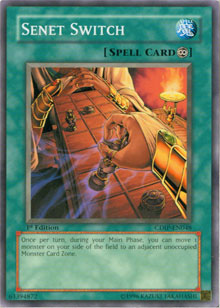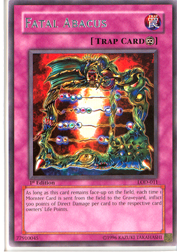 This article introduced two theories to the game: the Win Consistency Percentage (WCP) and a way to mathematically justify a side deck. The WCP is a constantly shifting number, which basically describes how often you win a game. This number is affected by your deck, your skills and even what you’ve eaten the day of the tournament. Every small edge you have over your opponent adds to this number, and it’s a large part of my approach to the game. By identifying this number, you can actively work towards improving it. By understanding something, you own it. Considering the difference between a consistently winning duelist and a mediocre duelist is often as small a margin as ten WCP, understanding this theory can give you the nudge you need to become one of the best.
This article introduced two theories to the game: the Win Consistency Percentage (WCP) and a way to mathematically justify a side deck. The WCP is a constantly shifting number, which basically describes how often you win a game. This number is affected by your deck, your skills and even what you’ve eaten the day of the tournament. Every small edge you have over your opponent adds to this number, and it’s a large part of my approach to the game. By identifying this number, you can actively work towards improving it. By understanding something, you own it. Considering the difference between a consistently winning duelist and a mediocre duelist is often as small a margin as ten WCP, understanding this theory can give you the nudge you need to become one of the best.
Mathematic side decking allows you to quickly and efficiently recognize the perfect amount of your side deck to focus on counteracting specific strategies. The strength of a side deck often dictates the winner of a match, and many players (even some of the best) have a lot of trouble generating a strong side deck. By understanding the math behind creating a side deck, you can get a significant edge over your opponents.
-Ryan
This week, we’ll be considering two different things: the Win Consistency Percentage (WCP) and mathematic side decking. While WCP is a new theory, it’s necessary for applying a lot of theory in the Yu-Gi-Oh! TCG, especially in terms of creating a side deck. Too many players are lax when they create a side deck; however, that’s the factor which will often turn the tide of a match. You have the chance to add cards to your deck to combat specific opponents, with complete knowledge of your opponent’s deck. If you aren’t taking advantage of that to full benefit, you need to remedy the situation. If you already engage in side decking, you’ll probably find the mathematic principles in this article to be helpful.
The Win Consistency Percentage
The WCP is the average proportion of matches won and lost by a given player, relative to specific matchups and dependant on the current metagame, one’s deck, and any other variable that could affect one’s play. It’s important to note the fact that your WCP isn’t constant; it is fluid and reacts to what deck you wield, your side deck . . . everything. The best of players will have somewhere near a 0.85 WCP, which has them winning about 85 percent of their games. That number is incredibly high (it calculates them losing only about two percent of their matches), but it might apply to some of the top players.
To calculate your WCP, you’ll need to keep track of about 100 games against every deck in the format that you expect to play against at least once at the event you’ll be traveling to. Obviously, this is where a large amount of guesswork enters the mix, as you cannot, with any real accuracy, calculate the percentage of people at an event that will be running a specific deck. However, you can gain a degree of accuracy by networking online, or even having a group of friends write down every deck they played against during a tournament in the area. From there, you calculate your WCP. Let’s assume you’ve played 100 games with a deck; let’s just call it deck A. Using deck A, your percentage of wins against each deck was as follows:
A: 0.5 (50%)
B: 0.9 (90%)
C: 0.85 (85%)
D: 0.2 (20%)
Now, let’s assume you expect the event you’re traveling to will have the following percentage of decks in attendance:
A: 0.1 (10%)
B: 0.4 (40%)
C: 0.3 (30%)
D: 0.1 (10%)
From here, we can calculate your WCP by multiplying your chances of beating a deck by your chances of playing a deck and adding those numbers together:
(0.5 * 0.1) + (0.9 * 0.4) + (0.85 * 0.3) + (0.2 * 0.1) =
0.05 + 0.36 + 0.26 + 0.02 =
0.69
In this situation, in the given metagame at this given tournament and using deck A, your WCP is about 0.69 (this is all assuming that the skill base will be, on average, the same as the person you tested against). 0.69 doesn’t seem like a very large chance at winning a given game, and you’d be right to assume it doesn’t give you very much of an advantage over a given opponent. However, remember that each match is actually two games, and the WCP doesn’t take that into account (and with good reason, as you can make your ability to side deck an advantageous variable in the equation, benefiting your tournament showing).
Instead of calculating how often we’ll beat a given deck, let’s calculate how many games we can expect to lose to a given deck. If we do this, we can calculate what decks cause us the most number of losses (it won’t always be our worst matchup; sometimes it would be foolhardy to side deck anything for certain matchups, even bad ones). However, it would be more useful to convert the percentage to a number of matches played against a deck; instead of ending with a percentage, we end with a solid number of games lost to a deck. Let’s assume this is a nine round Shonen Jump Championship (let‘s also assume that each match is only one duel — obviously, this is not for accuracy; it‘s for ease of use).
 A: (0.5 * 0.1 * 9)
A: (0.5 * 0.1 * 9)
B: (0.1 * 0.4 * 9)
C: (0.15 * 0.3 * 9)
D: (0.8 * 0.1 * 9)
You can expect to lose this number of games to each given deck:
A: 0.45
B: 0.36
C: 0.41
D: 0.72
You’ve just lost 1.94 matches, almost two. That might not be enough to make a day 2 showing, but don’t worry — we haven’t constructed our side deck yet! Now, you know exactly how many cards you should side deck against each deck. Just divide the number of matches you lost to each deck by the total number of matches you lost, and that’s the percentage of your side deck you should be using in each of your matches against the given decks (NOTE: multiplying the percentage by fifteen gives you the exact number of cards you should have in your side deck for any given deck; remember, some cards are good against multiple decks, and they can be counted toward both, allotting you extra room in your side deck).
A= side deck about 3.5 cards
B= side deck about 2.8 cards
C= side deck about 3.2 cards
D= side deck about 5.5 cards
You’ve just constructed a mathematically justified side deck, and most likely raised your chances of winning a given match far beyond what your original WCP projected. With a logical thought process governing your deckbuilding, all you need is well thought out play to make a day 2 showing.
I’d suggest that you go to an event with a preconceived side deck plan against each deck: you should already know what you’ll be adding to your deck and what cards you are taking out before you sit down for your first match. Don’t plan on being able to side deck perfectly without planning ahead: you’ll make mistakes. Hopefully, knowledge of the WCP will help you become a more concise, mathematic player, and this process of side decking helps you make a day 2 showing. Good luck, and remember to keep innovating and being introspective players!
-Ryan Murphy